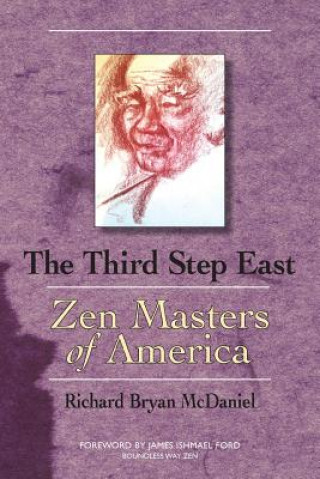
Kód: 12478245
Third Step East
Autor Richard Bryan McDaniel
In "The Third Step East: Zen Masters of America", Richard Bryan McDaniel continues the story, begun in his earlier work, of the spread of Zen from India to China ("Zen Masters of China: The First Step East"), thence to Japan ("Zen ... celý popis
- Jazyk:
 Angličtina
Angličtina - Vazba: Brožovaná
- Počet stran: 266
Nakladatelství: The Sumeru Press Inc., 2015
- Více informací o knize

Mohlo by se vám také líbit
-

Cypress Trees in the Garden
883 Kč -

Catholicism and Zen
640 Kč -

Sacred Hunger
356 Kč -

To Touch the Sky
484 Kč -

Legends Of The Celtic Saints
492 Kč -

Zen Masters Of China
449 Kč -

Zen Masters of Japan
449 Kč
Darujte tuto knihu ještě dnes
- Objednejte knihu a zvolte Zaslat jako dárek.
- Obratem obdržíte darovací poukaz na knihu, který můžete ihned předat obdarovanému.
- Knihu zašleme na adresu obdarovaného, o nic se nestaráte.
Více informací o knize Third Step East
Nákupem získáte 64 bodů
 Anotace knihy
Anotace knihy
In "The Third Step East: Zen Masters of America", Richard Bryan McDaniel continues the story, begun in his earlier work, of the spread of Zen from India to China ("Zen Masters of China: The First Step East"), thence to Japan ("Zen Masters of Japan: The Second Step East"), and then to North America and Europe. As McDaniel points out in the prologue to this book, the history of Zen practice in United States is less than a hundred years old. The first Zen priests sent to America from Japan were assigned to temples which served the immigrant population on the west coast. The temples functioned as community centers where traditional values were retained and respected. The priests' responsibilities were similar to those of their Christian counterparts, to perform wedding and funeral services, to conduct memorial services, and to carry ritual ceremonies for the benefit of their congregations. Although Zen was understood to be the meditation school of Buddhism, meditation was viewed as an activity for monastics and clergy, not for lay people. McDaniel's book demonstrates how this tradition was transformed into a lay practice in the west. He begins by examining the social and cultural factors in America which led to an initial theoretical interest in Zen during the 1940s and '50s, after which he profiles the individuals who fostered that interest, including D. T. Suzuki, Alan Watts, and the Beat Generation of writers. Ironically, during the 1960s, when Zen was on the decline in Japan-because the youth of that country viewed it as a remnant of the old feudal and the militaristic structures responsible for a the war that had ended so disastrously for the country-youth culture in America came to look upon Zen as a way of escaping from the intellectual and social constraints of their culture. Chapters are dedicated to the lives and work of the early teachers who established Zen practice in the West: Robert Aitken, Shunryu Suzuki, Eido Shimano, Taizan Maezumi, Philip Kapleau, Dainin Katagiri, and others. A summary of the main elements of the teaching styles of each of these is provided, giving readers an overview of the different training methods used by these pioneers and the ways in which they adapted an ancient Asian tradition to a new environment. The book also collects and retells some of the stories associated with these teachers which have begun to circulate within Zen circles, much as earlier tales of their Asian predecessors have done. The story of American Zen will be continued in a sequel to this work, entitled "Cypress Trees in the Garden", scheduled for publication by Sumeru in the Autumn of 2015. It will describe the heirs and legacies of the Zen Masters and teachers described in "The Third Step East".
 Parametry knihy
Parametry knihy
640 Kč
- Plný název: Third Step East
- Podnázev: Zen Masters of America
- Autor: Richard Bryan McDaniel
- Jazyk:
 Angličtina
Angličtina - Vazba: Brožovaná
- Počet stran: 266
- EAN: 9781896559223
- ISBN: 1896559220
- ID: 12478245
- Nakladatelství: The Sumeru Press Inc.
- Hmotnost: 414 g
- Rozměry: 234 × 156 × 15 mm
- Datum vydání: 25. February 2015
Oblíbené z jiného soudku
-

Dune
216 Kč -

Haunting Adeline
621 Kč -

Berserk Deluxe Volume 2
1092 Kč -

White Nights
89 Kč -

Powerless
268 Kč -

Atomic Habits
330 Kč -

Dune Messiah
228 Kč -

Berserk Deluxe Volume 3
1142 Kč -

One Day
221 Kč -

Berserk Deluxe Volume 1
1115 Kč -

Iron Flame
368 Kč -

Surrounded by Idiots
213 Kč -

Harry Potter and the Prisoner of Azkaban (Minalima Edition)
993 Kč -

Gravity Falls Journal 3
443 Kč -

Heaven Official's Blessing: Tian Guan Ci Fu (Novel) Vol. 1
440 Kč -

The Creative Act
568 Kč -

Dune
276 Kč -

Hunting Adeline
624 Kč -

A Little Life
290 Kč -

Children of Dune
230 Kč -

Heaven Official's Blessing: Tian Guan Ci Fu (Novel) Vol. 2
427 Kč -

Bungo Stray Dogs, Vol. 8 (light novel)
383 Kč -

Percy Jackson and the Olympians 5 Book Paperback Boxed Set
944 Kč -

Solo Leveling, Vol. 1
440 Kč -

The Prisoner's Throne
247 Kč -

Court of Thorns and Roses
268 Kč -

Cry Baby Coloring Book
276 Kč -

Fourth Wing
407 Kč -

Icebreaker
199 Kč -

Berserk Deluxe Volume 6
1089 Kč -

Avatar, the Last Airbender: The Kyoshi Novels (Box Set)
986 Kč -

The 48 Laws of Power
601 Kč -

House of Leaves
611 Kč -

Twisted Lies
213 Kč -

Dune Messiah
272 Kč -

No Longer Human
359 Kč -

48 Laws Of Power
331 Kč -

Twisted Games
213 Kč -

Caraval Paperback Boxed Set
902 Kč -

Solo Leveling, Vol. 2
468 Kč -

Open Circuits
907 Kč -

Berserk Deluxe Volume 5
1119 Kč -

Heaven Official's Blessing: Tian Guan Ci Fu (Novel) Vol. 3
476 Kč -

Berserk Deluxe Volume 4
1125 Kč -

Court of Mist and Fury
206 Kč -

SOLO LEVELING V08
436 Kč -

English File Upper Intermediate Multipack A (4th)
531 Kč -

CHAINSAW MAN V14
251 Kč -

Before the Coffee Gets Cold
184 Kč
Osobní odběr Praha, Brno a 12903 dalších
Copyright ©2008-24 nejlevnejsi-knihy.cz Všechna práva vyhrazenaSoukromíCookies



 Vrácení do měsíce
Vrácení do měsíce 571 999 099 (8-15.30h)
571 999 099 (8-15.30h)